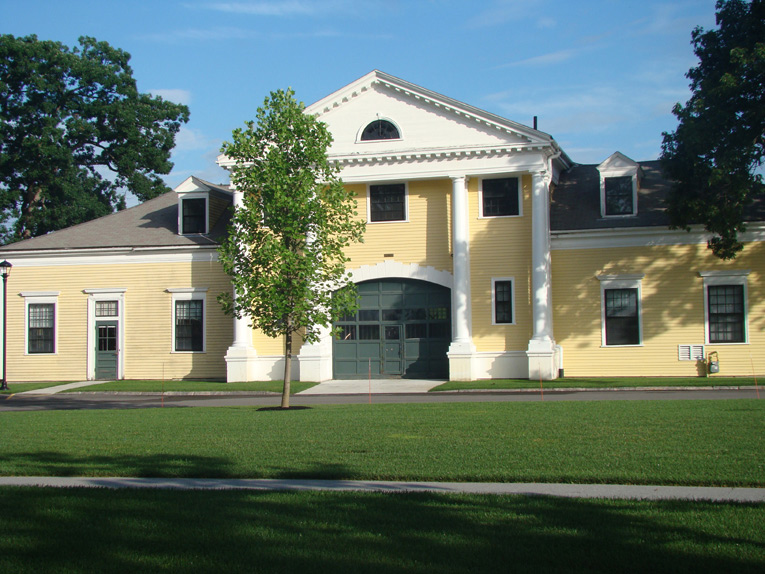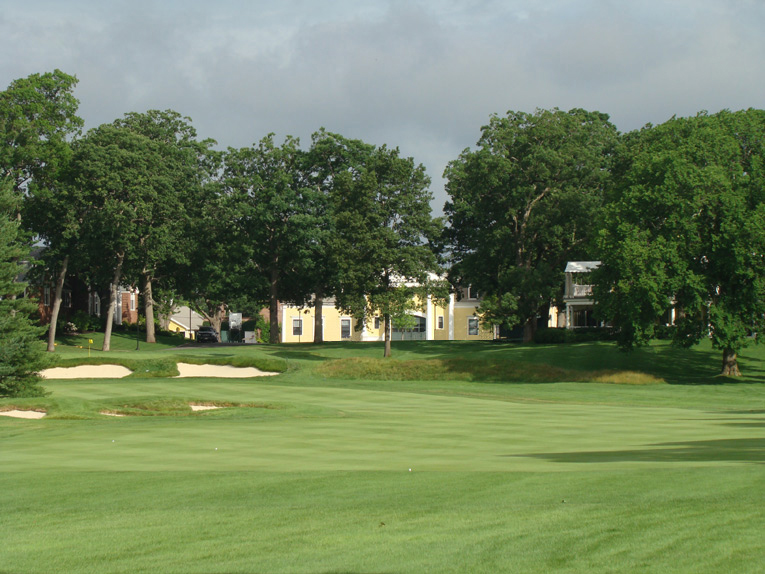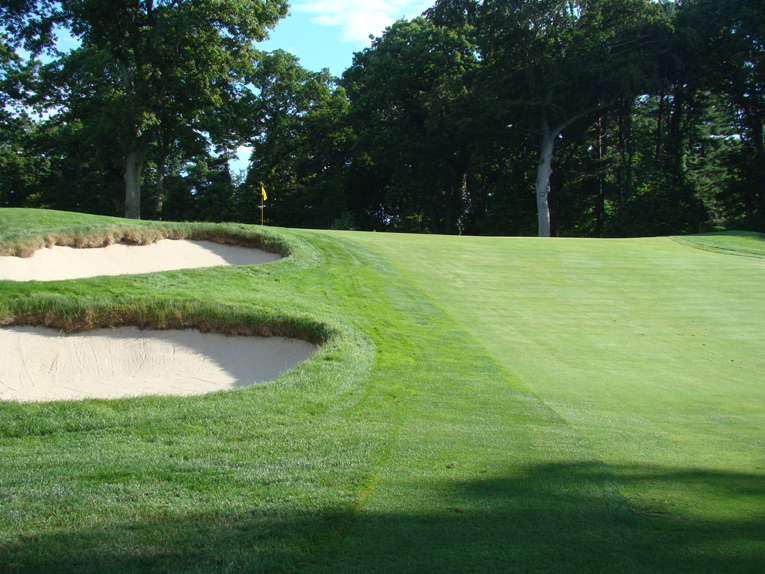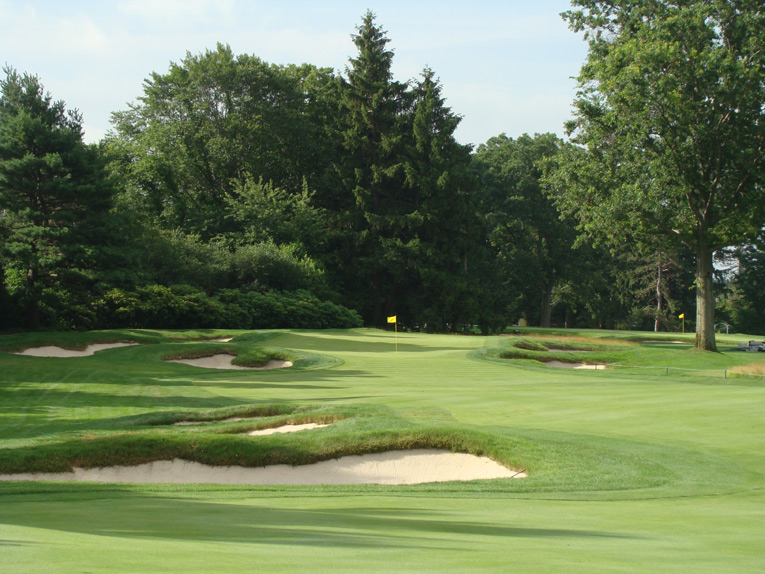Feature Interview with Frederick Waterman
August 2013
____________________________________________________________________________________

The 2013 U.S. Amateur Championship will be held at Brookline one hundred years after Francis Ouimet won the U.S. Open here as an amateur. Ouimet’s gentlemanly conduct still sets the standard upon which all amateurs are judged.
1. Please share with us your background. What are you presently working on?
I’ve worked as a writer since college, first as a reporter (which provided an excuse to interview Gene Sarazen, then to play golf with him), as a feature writer (talking to Stephen King for three hours exercises your imagination), then as a Boston-based sportswriter for United Press International (the assignments included the World Series, Super Bowl, Larry Bird/Magic Johnson NBA Finals, Wimbledon, the French Open, the Olympics, PGA and LPGA tournaments, and the 1988 U.S. Open at The Country Club).
My magazine work has included articles for Forbes FYI (best research: going to London to attend a school for butlers) and writing 27 short stories for the Row 22, Seats A & B fiction series in United Air Lines’ in-flight magazine (the story Best Man Wins was performed as a stage play in NYC and selected by Nelson DeMille for Best American Mystery Stories of 2004). I edited The Story of Golf at The Country Club, which won the USGA’s Herbert Warren Wind award in 2009 as the year’s best book about golf.
At present, I’m writing the history of the Newport Country Club; this was expected to be about 160 pages, but will end up closer to 320 because the history of the club is intertwined with the history of Newport itself. For example, when you find a French Army map at the Library of Congress that shows French troops during the Revolutionary War encamped on the land that would become the Newport Country Club, a full and complete history must reach back a lot further than the club’s 1893 incorporation.
2. Tell us about the early days at Brookline.
The name — “The Country Club” — sounds pompous and self-aggrandizing, but when TCC was founded, it was the only “country club” in the Western Hemisphere, so it didn’t need to distinguish itself from any other. J. Murray Forbes, the founder of TCC, was a China trader, and there was a lunch club in Shanghai called “The Country Club.” He liked the name, brought it back to Boston, and gave it to the sporting club he founded with his friends. All of the world’s sporting country clubs are the result of Forbes’ preference for that name. Golf wasn’t one of the original sports at TCC; the horse was king, so there was a racetrack, an enormous grandstand, and a steeplechase course, although the club did have some gentler pursuits like lawn tennis and croquet.

The horse stables are fifteen yards from the men’s locker building and act as a reminder that the horse was once king at Brookline.
3. How did golf come to be played here?
Florence Boit, one of the girls immortalized in John Singer Sargent’s painting The Daughters of Edward Darley Boit, learned to play golf in Pau, France, on the first course built on the European continent. In 1892, she came to visit her uncle, Arthur Hunnewell, and brought her golf clubs. After she taught Arthur and his friends to play, she went back to Europe, and they kept playing on the make-shift course they’d built on the Hunnewell estate in Wellesley. Then, they convinced The Country Club’s executive committee to spend $50 and build six holes.
4. Please tell us about the role The Country Club played in the founding of what is known today as the United States Golf Association.
In 1894, Charles Blair Macdonald finished as runner-up in the first national amateur tournament, in Newport, but raged that the event was invalid because of a stonewall on the course — conveniently ignoring the existence of Scotland’s iconic North Berwick course – and also said the championship’s stroke-play format was wrong, that match play was the only correct competition for amateurs. So, that fall, the event was replayed at St. Andrew’s in Yonkers — with no stonewalls — and as match play. When Macdonald was again the runner-up, he said the result was invalid because the tournament wasn’t sanctioned by a national organization. Now it was clear that a national organization was needed to control Macdonald — and there was concern that he might go off and start his own national golf organization. So, the leaders of Newport, The Country Club, Shinnecock, and St. Andrew’s, understanding that you should hold your friends close but your enemies closer, invited Macdonald’s Chicago Golf Club to join them in forming the Amateur Golf Association, which was soon re-named the American Golf Association — to include professional golf – then re-named again, as the United States Golf Association, because they had no control over Canada. After the USGA’s first president, Newport’s Theodore Havemeyer, died in 1897, TCC’s Laurence Curtis became the organization’s second president.
5. What is the architectural history of The Country Club course?
The first six holes were laid out in March 1893, at a cost of $50, after members Arthur Hunnewell, Laurence Curtis, and Robert Bacon petitioned the executive committee, who appointed the three men as the course’s designers. Whether any of them had ever seen a true golf course is unknown, although Hunnewell had laid out at least six holes on his Wellesley estate, perhaps with the help of his niece, Florence Boit, who had played the course in Pau, France. The Country Club’s six holes were soon expanded to nine holes, and these were lengthened in 1895 with the assistance of the club’s first golf professional, Willie Campbell. A full 18 holes were opened in October 1899, then the 18-hole layout was lengthened in 1903 with the help of the club’s professional at the time, Alexander “Nipper” Campbell. In 1905, 32 acres were purchased, which allowed for the construction of three new holes. Another 55 acres were purchased in 1923, and Philadelphia-based architect William Flynn was hired to design the Primrose course. Three of the hardest holes in the current championship routing — Nos. 11, 12, and 13 — are taken from “the ‘Rose.”
6. Walk us through the origin of holes 11-13 on the Main Course.
Coburn Haskell out in Ohio may never have known it, but he was responsible for the creation of three of The Country Club’s holes. It was 1899 when he patented his idea of wound, rubber strings inside a golf ball; in 1901, he established the Haskell Golf Ball Company. Two members of TCC – Herbert Jaques and Herbert Windeler — recognized that the Haskell ball’s longer distances would render The Country Club’s course obsolete, but they couldn’t convince a majority of the board, so in 1905 they gathered a group of golfers to support the $14,000 purchase of 32 acres. The members who lacked foresight called the three new holes “Jaques‘ Folly,” “Windeler’s Folly,” and “Their Combined Folly,” just as the purchase of Alaska by Secretary of State William H. Seward was known as “Seward’s Folly.” Eventually, the board at TCC recognized the wisdom of the golfers’ purchase and took over the mortgage payments.
7. What work did Geoffrey Cornish do at The Country Club?
Cornish was hired to prepare the course for the 1963 Open, and he remodeled the greens on championship course holes 1, 17, and 18. The racetrack that circled the 1st and 18th fairways was removed in 1969, and Cornish was brought back to make those two holes into more-pronounced dog-legs to allow for the placement of a driving range between them. On the Primrose course, he built two new greens, Nos. 6 and 7, that are not part of the routing for the championship course.

The Home Hole was original straight but Cornish made it and the first into slight dogleg lefts to accommodate a practice area.
8. How much did Rees Jones have to do with the course we see today?
A lot. He restored the course to a consistent, early 1900′s style. The work that he did in the mid-1980′s, in preparation for the 1988 Open, was extensive. He re-modeled Cornish’s greens at Nos. 1 and 17, worked on No. 4, and added surface to greens 3, 7, 8, 9, 10, and 11. He also worked on the tees for every championship-course hole but No. 7; worked on the fairway bunkers on Nos. 1, 4, 6, 8, 9, 14, and 18; on the green-side bunkers of Nos. 1, 4, 5, 8, 9, and 12, and the mounding on holes 1, 2, 5, and 14. Jones is proud of the work that he did at The Country Club, and rightfully so. His work here helped launch his career as a man who could “doctor” a course before it hosted a U.S. Open.
9. How did the 1913 U.S. Open come to be contested in September?
In January 1913, the USGA voted to hold that year’s U.S. Open at The Country Club in Brookline. Then, it became known that Harry Vardon, a five-time winner of the British Open, and Ted Ray, then the reigning British Open champion, would be in the U.S. from August to October for a national tour. Another factor was that club professionals in the northern states were expected to be at their clubs during the busy summer months, so they wanted the Open to be played outside of their busy (and most profitable) season. In February, the USGA voted to re-scheduled the U.S. Open for the third week of September.
10. How long was the course for the 1913 U.S. Open? 1963 U.S. Open? The 1973 Walker Cup? The 1989 U.S. Open? The 1999 Ryder Cup? And the 2013 U.S. Amateur?
6,245 yards, bogey of 80 for the 1913 U.S. Open (please note: using hickory clubs, this event was played strictly over the Main Course as the Primrose nine did not exist at that time.)
6,870 yards, par 71 for the 1963 U.S. Open. (No. 12, 470 yards to an upper plateau, is played as a par 4.)
6,875 yards, par 72 for the 1973 Walker Cup (No. 12, at 480 yards, is played as a par 5.)
7,010 yards, par 71 for the 1988 U.S. Open (No. 12 is reduced by 30 yards; more than 50 yards are added to No. 18, and 10-20 yards are added to several other holes.)
7,033 yards, par 71 for the 1999 Ryder Cup (No. 12 is lengthened to 486 yards, but remains a par 4.)
7,310 yards, par 70 for the 2013 U.S. Amateur. (No. 12 is lengthened to 623 yards and will be a par 5; No. 9 (505 yards) and No. 14 (508 yards) are reduced to par 4’s despite playing to uphill greens.)
11. What has been the range of green speeds over this one hundred year period?
If any place should know, it is here because the Stimpmeter was invented by TCC member Edward Stimpson; one of the original stimpmeters hangs in the clubhouse). For the Amateur, the “stimping” range will be 10 1/2 to 11, but not faster because several of the greens — especially Nos. 5 and 10 (championship course) — are sharply tilted and were designed for slower speeds, so the greens would become unfair if they were made too fast. TCC’s greens have so many subtle contours that they don’t need to be made linoleum-quick to be a challenge. Because the Stimpmeter was invented during 1935-36, we can only guess at the earlier speeds. Course Superintendent Bill Spence believes they were in the 4 to 5 range for the 1913 U.S. Open. Before the 1963 Open, Ouimet said that the greens in 1913 were similar to the fairways in 1963.
12. The Country Club has small greens and small bunkers. We know how many greens are on the championship course, but how many bunkers are there?
A total of 103, with nine bunkers on three holes: Nos. 6, 14, and 17. Although Nos. 6 and 17 are under 400 yards, the bunkers might deter some of the more-aggressive play. The holes and their bunkers: 1-5; 2-6; 3-6; 4-8; 5-4; 6-9; 7-2; 8-8; 9-7; 10-4; 11-2; 12-8; 13-2; 14-9; 15-4; 16-4; 17-9; 18-6. (Two of the bunkers on No. 2 are designed to be hazards only when the hole is played as a par 4; they are unlikely to come into play during the Amateur.)
13. The twelfth hole on the championship course will be played as a 623-yard par 5. Tell us about it.
The 12th hole will likely be the most interesting hole for spectators because our consulting architect Gil Hanse moved the tee-box back more than 135 yards, across a pond, and the players’ decision-making will be tested. If they don’t have a long drive in the fairway, a second shot to the upper plateau might not be wise because if they land in the hillside fescue, the hole can be over for them, whether or not they find their ball. What players decide to do might have as much to do with their being in their teens or early 20s as it does with cool-headed wisdom. In last year’s U.S. Amateur at Cherry Hills, Steven Fox won the first playoff hole, the par-4 No. 1, hitting six-iron off the tee, while Michael Weaver hit driver on the 338-yard hole that was reachable but also surrounded by trees. At Brookline, the players who survive will keep learning the course, but, as Ben Crenshaw said, this course “requires a lot of knowing.” An experienced TCC caddie will be invaluable.

This fierce thirty foot rise is 490 yards from the tee – getting past it in two shots is imperative.
14. Anything else new this championship we should be on the look out for?
Yes. For the first time ever in a National championship, holes No. 9 & No. 14 will play as par 4s. I’m interested to see how the players deal with No. 14, a 508-yard par 4. The green is on a plateau, and if the pin is put on the front third of the green, a putt can easily trickle past the cup, off the green, and down the hill. So, imagine a player putting off the green and ending up 70 feet from the pin, but in the middle of the fairway. He then declares an unplayable lie and replaces his ball on the green, even if that means placing it two feet from the cup. Anyone who doesn’t know Rule 28 — and especially a match-play opponent — will never forget that moment.

Imagine trying to hit this firm, elevated target from 200 plus yards away! Short is no good and long might be worse.
15. Why does the seventeenth wreak so much havoc?
The 17th is a cunning hole. This is a dog-leg left and enticingly short at 371 yards, but has nine bunkers and a two-tiered, angled green. Your strategy must be sound on your tee shot and your approach shot, and despite Justin Leonard’s 40-foot birdie putt in the 1999 Ryder Cup, this is a brutal green. One reason for this hole’s importance, historically, is because it comes late in the round, and with a championship at stake, players feel the pressure to gamble. In the 1913 U.S. Open playoff, Harry Vardon was one shot behind Francis Ouimet (Ted Ray was now five shots back), and Vardon tried to cut the corner with his drive, but ended up in the one extant bunker and had to take a bogey. (This bunker is now known as “Vardon’s Bunker,” which proves again that you never want a bunker named after you.) Ouimet, who had walked this hole thousands of times while caddying and while cutting across the club’s land to go to school, knew the percentages and hit his tee-shot to the right side of the fairway; he put his second shot safely on the green and sank an 18-foot putt for a three-shot lead. In the fourth round of the 1963 Open, Jacky Cupit didn’t know that he had a two-shot lead, so he tried to draw a 3-wood around the bunkers — a second bunker had been installed — and his tee shot rolled through that bunker into heavy rough. He took a double-bogey, then lost to Julius Boros in the playoff. In the 1988 Open, Curtis Strange led by one shot but three-putted for a bogey and fell into a tie with Nick Faldo, whom he beat in the playoff. An approach shot that misses right of the green and greenside bunkers might leave the hardest shot on the course; due to an overhanging tree and the narrowness of the green, the best strategy can be to hit into one of the bunkers.
16. When was 17th green moved to its current position?
In 1958, the Town of Brookline needed to expand Clyde Street, which ran near the 17th green, made famous by Francis Ouimet’s two birdie putts in the 1913 U.S. Open: the first one, in the fourth round, tied him with Harry Vardon and Ted Ray, then the second one, in the playoff, basically assured him of the Open title. So, the club built a new green, about thirty feet to the right (south), which rendered the hole less of a dog-leg. Like the original green, the current green has a higher, back plateau.

The seventeenth was once a sharper dogleg. Cornish laid the ground work for the current, exquisite green complex in the late 1950s.
17. The U.S. Amateur is stroke play followed by match play. Does the strategy change on certain holes (perhaps 4 or 6) depending on the format?
The one attribute that makes a golf course enjoyable and worth playing again and again is the same attribute that makes it a great match-play course: constant decision-making. Alistair Mackenzie believed that a dog-leg is the perfect design for a hole because the golfer must start making decisions as he stands on the tee-box. Can the angle be carried? What if it can’t? Is the risk worth the reward? On the course that will be used for the Amateur, 12 of the 15 par-4’s or par-5‘s are dog-legs, mild or severe. Only Nos. 6, 13, and 15 are designed for two straight shots to put you on the fairway and then the green. The greatest compliment to a hole is a golfer standing on the tee box, unsure what shot to hit. It is very possible that in the match-play competition, opponents will hit different clubs from the tee on a majority of their holes. The short par-4’s at TCC will be revealing during both stroke play and match play. No. 4 is only 338 yards, but the green is the smallest on the course: 2,100 square feet. Go ten yards over the green and you’re in deep brush. No. 6, is even shorter, at 310 yards; during the Ryder Cup, the Americans could not resist and tried to drive the green; the Europeans simply hit to the bottom of the hill and put a wedge on the green. The Europeans fared better. The player must ask himself, does he want to hit the big shot or does he want to win the hole? At TCC, the player will have to decide. This is a course of hard choices.
18. You mentioned a fascinating fact to me regarding the U.S. Amateur that Tiger Woods won at Newport Country Club. Please share that with us here. Do you think a similar phenomenon will occur at TCC?
At the 1995 U.S. Amateur at the Newport Country Club, a course that is an amalgam of holes designed by Willie Davis in the 1890s and Seth Raynor and A.W. Tillinghast in the 1920s, four of the eight quarterfinalists were in their 30’s, and another quarterfinalist was 19-year-old Tiger Woods, who likely had more tournament experience than anyone in the field. Judicious decisions were essential, especially on the greens, where a too-aggressive chip or too-bold putt could be disastrous. The same is true at The Country Club, but starting with the tee shot. You must take what the course gives you and not try to impose your game on it. Not every course suits every player. During the 1963 Open, Arnold Palmer tried to over-power the 11th hole — a long, par-4 dog-leg over water — and he ended up with two triple-bogeys and a bogey; one of the triples, during the playoff with Julius Boros and Jacky Cupit, involved Palmer’s famous “stump shot.” Nicklaus did not come close to winning in the three national championships he played at TCC, losing in the fourth round of the 1957 Amateur; missing the cut in the 1963 Open, when he was the defending champion; and tying for 25th in the 1988 Open.
19. You have played the course hundreds of times. What advice would you offer the players next week? Where do people unfamiliar with the course tend to go awry?
Players who show up at TCC without a good flop shot and good nerves will go home early. The green-side grass can be deep and, after you find your ball, you can be left with a hold-your-breath flop shot to a pin perhaps six feet away. I remember playing two rounds with a 4-handicapper who didn’t have a flop shot; he didn’t break 90 either day. Also, because the greens are so old, they have settled, and there are subtle breaks that will leave players staring at the hole after missed putts. Few short putts should be given, especially those that are downhill; a three-footer can become a 20-, 30-, or 40-footer, or, on No. 14, even 70 feet when the ball runs off the front of the green and down the hill. Depending upon the pin placements, fear can be a wiser guide than courage.
20. From the perspective of a long-time member, what are the course’s lasting attributes?
We are a problem-solving species; otherwise, there is no explanation for crossword puzzles or jigsaw puzzles or golf. At TCC, it regularly happens that smart players beat superior ball-strikers. TCC is a tactical course, and experience is crucial. It wasn’t by chance that Jay Sigel, the winner of the last Amateur at TCC , in 1982, was 40 years old. The members like the course because it is a puzzle to be solved, and because every round of golf is different, the puzzle always changes. You can go to a driving range to see who hits the ball the farthest and is the best ball-striker, but a course that challenges players’ shot-making and strategy will reveal the better player. And that goes to the core reason why we all play golf and, on the best courses, look forward to tomorrow’s round.
THE END






